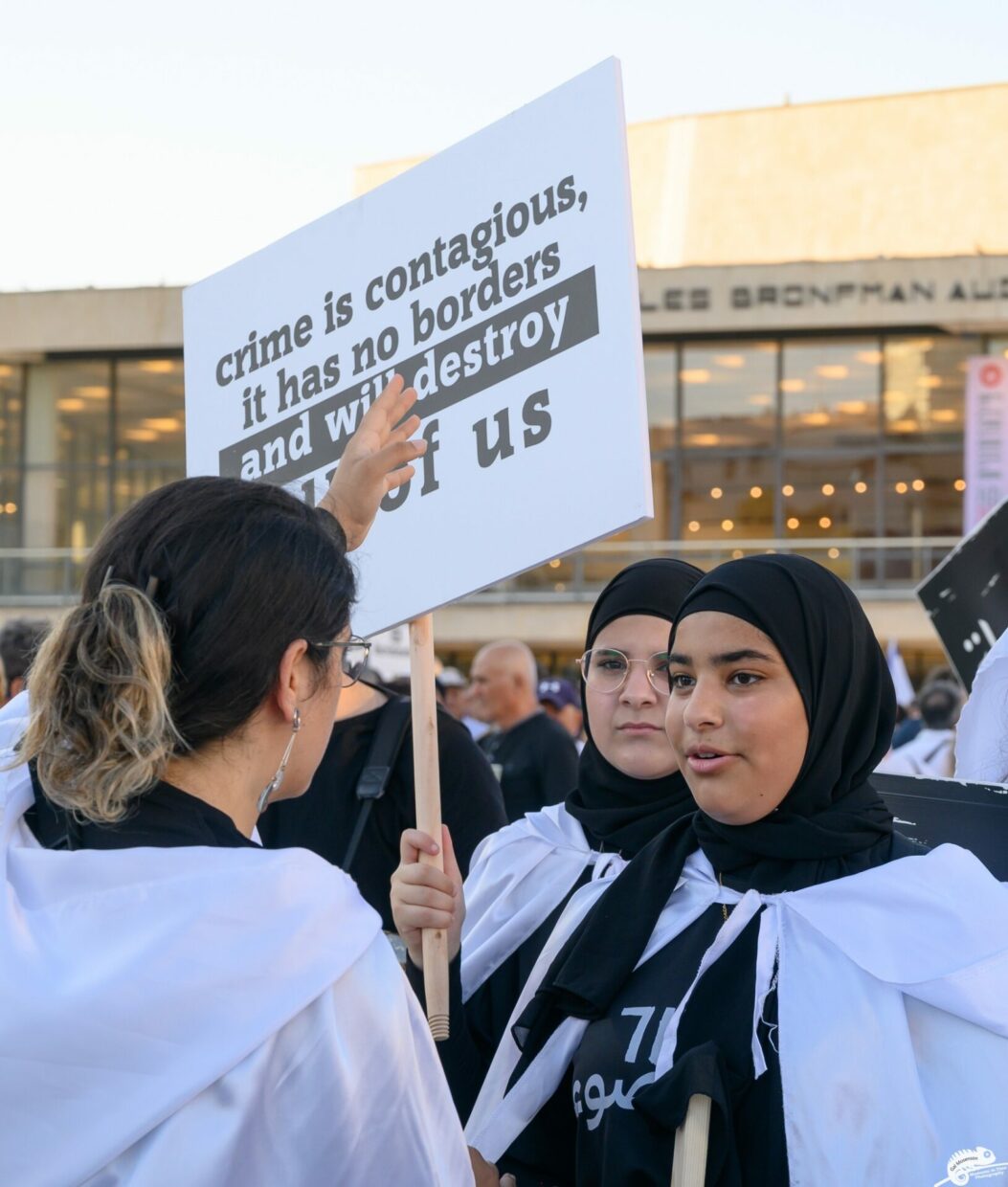
The image above, captured by movement photographer Gal Mosenson, comes from a protest held yesterday in Tel Aviv in support of the Arab-Israeli population. As some commentators have mentioned, Arab-Israelis are conspicuously and understandably absent from the pro-democracy, anti-government protests; the proliferation of Israeli flag and the coalition with centrist movements, obscuring the occupation of Palestinian land and the horrors visited not only on Palestinian refugees but on Israeli citizens who are ethnically Palestinian, are huge hindrances to collaboration. Yesterday’s protest organizers asked their Jewish allies to show up without protest t-shirts or Israeli flags.
I’ve previously posted about rising crime rates amongst Arab-Israelis, and things have grown even more dire since then: the number of murder victims is skyrocketing. The confusion among civil rights organizations whether to support the Arab-Israeli demand for assistance from a police force that oppresses and uses violence echoes some of the dilemmas that James Forman spelled out in Locking Up Our Own. But there’s something deeply patronizing about downplaying calls from thoughtful citizens who have realized that they simply cannot have their kids leave the house out of fear of shoot-outs and family vendettas gone wrong.
Meanwhile, in the New World, similar calls are being heard regarding crime rates in Oakland and San Francisco. The Oakland call comes from no other than the NAACP:
Oakland residents are sick and tired of our intolerable public safety crisis that overwhelmingly impacts minority communities. Murders, shootings, violent armed robberies, home invasions, car break-ins, sideshows, and highway shootouts have become a pervasive fixture of life in Oakland. We call on all elected leaders to unite and declare a state of emergency and bring together massive resources to address our public safety crisis.
African Americans are disproportionately hit the hardest by crime in East Oakland and other parts of the city. But residents from all parts of the city report that they do not feel safe. Women are targeted by young mobs and viciously beaten and robbed in downtown and uptown neighborhoods. Asians are assaulted in Chinatown. Street vendors are robbed in Fruitvale. News crews have their cameras stolen while they report on crime. PG&E workers are robbed and now require private security when they are out working. Everyone is in danger.
Failed leadership, including the movement to defund the police, our District Attorney’s unwillingness to charge and prosecute people who murder and commit life threatening serious crimes, and the proliferation of anti-police rhetoric have created a heyday for Oakland criminals. If there are no consequences for committing crime in Oakland, crime will continue to soar.
People are moving out of Oakland in droves. They are afraid to venture out of their homes to go to work, shop, or dine in Oakland and this is destroying economic activity. Businesses, small and large, struggle and close, tax revenues vanish, and we are creating the notorious doom-loop where life in our city continues to spiral downward. As economic pain increases, the conditions that help create crime and criminals are exacerbated by desperate people with no employment opportunities.
Notably, their call to action recognizes the progressive shaming that hinders action, and they call out the relevant communities without mincing words:
We urge African Americans to speak out and demand improved public safety. We also encourage Oakland’s White, Asian, and Latino communities to speak out against crime and stop allowing themselves to be shamed into silence.
There is nothing compassionate or progressive about allowing criminal behavior to fester and rob Oakland residents of their basic rights to public safety. It is not racist or unkind to want to be safe from crime. No one should live in fear in our city.
A somewhat more tepid call, but still important, comes from San Francisco’s NAACP President:
It can be difficult to exercise compassion when the situation is this dire. In one of the wealthiest cities in the world, poverty remains a significant problem, made worse by ever-increasing income inequality. Too often, our reaction to this suffering is to call for it to be removed in sweeps that only create more suffering by moving the problem to a new place in the city. We have seen regrettable responses, such as the owner of a North Beach art gallery who sprayed an unhoused woman with a hose when she refused to move from the sidewalk in front of his business. I understand his frustration, but as difficult as it is, we must exercise compassion; today, I am working with the gallery owner to help him through this challenge.
But compassion must be accompanied by responsibility.
First and foremost is for people in this city to take personal responsibility, even in the most difficult of circumstances of being unhoused.
Setting up an encampment underneath an occupied building and setting open fires, as has happened recently in the Haight, is utterly unacceptable. So is erecting a tent city that prevents others from safely walking in their neighborhoods or makes it dangerous for them to come and go from their own homes. Engaging in open drug use, committing violence and carelessly creating unsanitary conditions are all the outcome of a lack of personal responsibility.
We also must practice community responsibility. Those who need help should be able to receive it, and we need to take the steps to streamline the creation of safe, affordable housing to get people off the streets permanently. At the same time, there must be consequences for those who refuse help yet continue to refuse to take personal responsibility for their actions.
Perhaps the most important thing we need, however, is accountability — by the city, by the array of agencies and organizations that serve the unhoused and those dealing with addiction, and by the larger community. Too much money is spent without effective oversight, coordination and collaboration. We can provide an individual with some of the help they need but fail to connect them with other essential resources. Organizations duplicate efforts, work at odds with one another, and in the end, fail to solve the problem they all profess to be fighting.
I assume the culture wars will now lead to an argument that the NAACP has sold out to white supremacy or whatever (the term “personal accountability” in particular, as my friend Paul Belonick notes, will be read by some as a right-wing dog whistle), but that would be reductive, disappointing, and mostly disrespectful. At some point, this movement will have to contend with the fact that the call is coming from inside the house, and that the big talk about “lived experience” means we should believe people who tell us they can’t live with crime around them.
Twenty years ago, when I studied radical/critical criminology, it struck me that the biggest weakness of Marxist/critical race theories were that, for all the political incentives of the oppressed to fight against the machine, the vast majority of poor people of color do not commit crime. And the fact that crime, especially violent crime, tends to operate intraracially. The radical rhetoric was intoxicating, but after years in the military defense, seeing how the haves and the have-nots fared, I realized that left realism was the best framework for understanding what I saw around me. What is novel and worthwhile about the calls for help from the Arab-Israeli community and from the Bay Area NAACP chapters is that it’s not just about oppression: they realize that enforcement must come hand in hand with opportunities for youth, otherwise there is no hope for the community. The Oakland NAACP writes:
Our youth must be given alternatives to the crippling desperation that leads to crime, drugs, and prison. They need quality education, mentorship, and, most importantly, real economic opportunities. Oakland should focus on creating skilled industrial and logistics jobs that pay family sustaining wages, and vocational training so Oakland residents can perform those jobs. With this focus we can produce hundreds, if not thousands, of the types of jobs desperately needed to stem economic despair. Unfortunately, progressive policies and failed leadership have chased away or delayed significant blue collar job development in the city, the Port of Oakland, and the former Army Base. That must change!
We also must continue with mentoring programs like the Oakland branch of the national OK Program that steers youth away from criminal activity. We believe that young people currently in the criminal life will choose another path if they are shown a way.
The idea that improving opportunities reduces crime is not new. It comes from Cloward and Ohlin, architects of Opportunities Theory. Even in the late 1950s it was evident that young people treated as second-class citizens make use of the opportunities available to them, and those tend to be illegitimate opportunities. This is common sense, but what I see all around me (Elizabeth Hinton’s From the War on Poverty to the War on Crime is a prime example, but there are others for sure) is derision of Cloward and Ohlin as white, top-down do-gooders who are almost (if not absolutely) worse than rightwingers. The appeal of Hinton’s argument is that it is clever and counterintuitive, and it is just perverse enough to appeal to academics who don’t have to actually deal with the people victimized by crime in dilapidated neighborhoods. Margo Schlanger presents this critique against another one of these lefties-are-worse-than-conservatives books, Naomi Murakawa’s The First Civil Right.
The secret truth–the thing that happens to best reflect reality, but does not fill auditoriums or gets you coffee with the cool people at socio-legal conferences and punishment workshops–is that Cloward and Ohlin were right. It’s not sexy to talk about namby-pamby proposals for reform, but Lyndon Johnson had the right idea initially, as did Kennedy, and the reason it didn’t work is related to a lot of things, but not to the fact that crime was just a figment of the conservative imagination. Crime was real in the 1950s, and it was real in the 1980s, when lots of people had to live in environments saturated with lethal violence brought about by the crack epidemic. That the CIA is now widely, and rightfully, acknowledged as having at least negligently brought that about by turning a blind eye from midlevel drug dealers, doesn’t mean those years did not exist. It does not mean that thousands of people did not die from addiction or addiction-adjacent violence, and many more ended up incarcerated for the same reasons. Reality is not spicy, but it’s an essential ingredient in cooking up criminal justice policy. And who best to obtain a reality check from than the people who have to live with the outcomes?
If I’m going to be truly respectful–listening to people’s “lived experience” in crime-ravaged zones not only when it fits my politics, but whenever they opine about something they actually know best–I have to respect that the call for crime control is coming from inside the house, from unimpeachable, reliable sources, and that the wave of pretending that crime doesn’t exist either has crested or is very close to cresting. Criminal justice professionals like Pamela Price might realize that her constituents don’t actually want the sort of nonjustice her office is doling out (I read that scenario as different from Chesa’s recall, but there are parallels.) Whoever brings about nonjustice ends up with Nancy O’Malley or Brooke Jenkins as DAs, and that is not a scenario in which anyone, right to left, can thrive.
______
Hat-tip to Paul Belonick and Emily Murphy for the NAACP links.




2 Comments
Such a thoughtful piece. Thank you. It’s weird how little actual analysis there is out there… you’re piece offers such a welcome corrective.
I’m writing from Oakland, but as a scholar of Latin America
I’ve started to think that it’s important to envision property crime in the Bay Area as the emergence of a new business model. In my humble opinion, this would allow us to theorize class divisions among the victims and perpetrators of crime, and embrace calls for accountability, in ways that most “progressives” cannot
This is so connected to climate change too… When London Breed called out Hondurans recently, that was part of the picture
Thanks for your work! Super helpful
There are lots of ways to slice this cake that don’t call for ignoring it or pretending that it is terrific as the one and only appropriate progressive response. When I see folks setting dozens of joints on fire inside a closed BART car between West Oakland and Embarcadero, I don’t think that my desire not to perish in a fire with no means to escape makes me into some kind of supremacist bigot. Which is what I’m trying to get at here.
I will also say that each of the two cities–Oakland and SF–has a somewhat different class/ethnic ecology, and while the two situations are analogous, they are not the same. For example, I think the Chesa recall features factors that are endemic to SF.